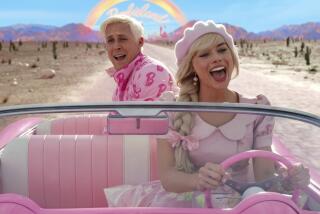Lacking Sex, Religion or Leaders, Arab Cartoonists Limited in Subjects for Ridicule
- Share via
MANAMA, Bahrain — Arab cartoonists can poke fun at anything as long as it is not sex, religion or their leaders.
But they are still freer than Arab writers, to judge from some of the works of 43 cartoonists from 15 Arab and four Western countries on exhibit at an Arab cartoon festival in Bahrain.
“Cartoons are important in our society because there is no direct freedom of speech,” the editor of the London-based Arabic daily Asharq al-Awsat said.
“Cartoonists can offer an opinion. They have a much wider range of possibilities with which to express themselves,” editor Othman al-Omeir said at the festival.
There are limits, however. Islamic taboos about sex, the sensitivity of most Arab leaders to criticism and Muslim fundamentalists alert to any religious mockery dilute the acidity of the pen.
“There is no room for laughter in our religion,” Khalid Kishtainy, a columnist for Al-Awsat, said. “It will be a long time before this changes.”
He said a controversy over Tunisian artist Youssef Seddik’s comic strip, entitled “Koran,” showed how severe the restrictions against offending Islam are. The 46-member Islamic Conference Organization branded Seddik a heretic, saying he profaned the Muslim religion.
“By indulging in a sacrilegious act which breaches the authenticity of the holy Koran, the author of this series of cartoons has committed an act of true heresy harmful to Islam and Muslims,” ICO Secretary-General Hamid al-Gabid said.
Seddik, a Paris-based journalist turned scholar, has said he spent five years perfecting his comic-strip version of stories told in the Koran to make them more accessible to children.
It was not surprising that the first modern Arab cartoonists were mostly non-Muslims, said Kishtainy, because many Muslims interpret the Koran as forbidding drawings of people.
The United States, however, is fair game. Libya’s Mohamed Zwawi displayed an evil-looking Uncle Sam drinking blood through a straw from a globe clutched in his talons.
The International Monetary Fund is another target. Egypt’s Ali Osman penned a cowboy with an IMF logo on his back before an emaciated cow branded “Third World” with interest rather than milk going into the bucket.
There were several examples of caricatures of world leaders but only one of an Arab--Palestine Liberation Organization leader Yasser Arafat.
The main themes favored by the cartoonists reflect Arab preoccupation with the Palestinian uprising in the Israeli-occupied territories, the Lebanese conflict and perceived American domination of the Third World.
Iraqi Raid Arrawi depicted an army general mowing down the flowers on his lawn with a miniature tank.
Syrian Yusuf Abdulki showed a crippled Palestinian leaning on a crutch in an Israeli jail, his mouth contorted in a grin as hooks weighted with missiles hung from his cheeks.
Several drawings by the late Palestinian cartoonist Naji al-Ali, who was killed by an assassin in London in 1987 after being expelled from Kuwait in 1985, were on display.
The plight of the poor was a popular theme. Algerian artist Qasi Rashid drew an Arab man riding through the desert on a donkey and dreaming of a Rolls-Royce. His veiled wife trudging behind him was also dreaming--of a new pair of shoes.
More to Read
Sign up for Essential California
The most important California stories and recommendations in your inbox every morning.
You may occasionally receive promotional content from the Los Angeles Times.













